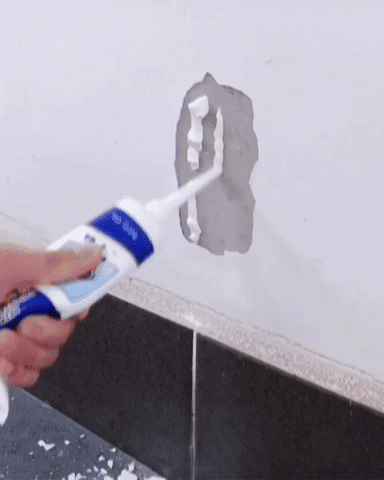

- #WHITE PASTE TO COVER WALL HOLES HOW TO#
- #WHITE PASTE TO COVER WALL HOLES PATCH#
- #WHITE PASTE TO COVER WALL HOLES FREE#
Feather the paint from the outside borders in. Don’t have the original? Scrape off a little and ask your paint store to match it.įor touch-ups, use the same type of brush or roller the original painter used.

Prepare for inevitable touch-ups by keeping leftover paint or at least recording the paint number and/or formula (paint names change). Wet and wring the eraser before attacking scuffs. Clean Magic Eraser ($3), the best instant wall cleaner around. To repair walls decorated with crayon marks, dab toothpaste onto a towel or toothbrush and scrub marks.Dip a sponge into an earth-friendly and slightly abrasive paste of dish soap, baking soda, and water, and gently scrub grime.Pour a little dish soap onto a damp cloth and wipe the mark.(Test a hidden spot to make sure the cleaner doesn’t take off paint with the mark.) Spray an all-purpose cleaner onto the cloth (never directly onto walls to avoid drips) and swipe the scuff.To get rid of scuff marks and fingerprints: Microfiber cloths are little miracles that erase the evidence of a childhood well spent, drawing on and caroming off walls. Sand until smooth and flush with the rest of the wall, then repaint. To repair walls pocked with pops, hammer the popped nail back into the wall or pull it out with a needle-nose pliers refasten the drywall to the nearest stud with a couple of screws, then fill dents with two or three coats of joint compound. Nail pops: Nail pops travel in packs: Rarely do you see just one. You’ll need at least two thin coats of compound and fine grit sandpaper to blend repairs into the rest of the wall. Cut wall repair time by thoroughly wiping away excess spackle.įist-sized holes: Joint compound is your best bet when covering the mesh or drywall patches that cover big holes. Spackle adheres to painted walls better than joint compound, though it takes a bit longer to dry.
#WHITE PASTE TO COVER WALL HOLES PATCH#
Patch Drywall to Smooth WallsĪ putty knife, spackle, or joint compound can repair wall damage that ages a room.ĭents and dings: A quart of spackle ($11) and a putty knife can fill dozens of small wall indentations.

#WHITE PASTE TO COVER WALL HOLES HOW TO#
Here’s how to fix your home’s face in a hurry. Fortunately, repairing walls is a good weekend warrior project. And, as always, for more insider tips and tricks from local AZ painting contractors, subscribe to our blog.Repair walls filled with dents, dings, and scuffs, and you’ll make rooms look young and fresh and maintain the value of your home.
#WHITE PASTE TO COVER WALL HOLES FREE#
If you have any questions about the procedure, feel free to get in touch with us. Prime-Line U 9271 Wall Protector, 5 inch, Smooth Surface, Rigid Vinyl, White 4.7 (7,231) 29913. There’s no reason to fear painting over a wall that’s been repaired with spackle! AZ painting contractors like us see this situation all the time, and we promise it’ll turn out just fine. : Wall Hole Cover 1-48 of over 40,000 results for 'wall hole cover' RESULTS Price and other details may vary based on product size and color. Do try to use a matte paint the glossier your paint, the more visible any imperfections will be. The texture and color should match perfectly, once everything has dried. Go over the repaired area just as you would any other area.

Now, you’re ready to use your roller to paint the entire wall. If you don’t do this step, the affected area will have a different texture than the rest of the wall once the job is over. Paint the repaired area firstīefore getting out the roller, use a small brush to cover the area that’s been repaired with spackle in a thin layer of regular paint. If you only have a few small spackle spots, you can skip the primer and head straight to the next step. Use your fingers to check for flushness, as they’re more reliable than your eyes. It dries faster than joint compound, typically within half an hour. To do this, spread the spackle out beyond the edges of the repair during application, and then sand it down after it dries. Spackle is used to fill in dings and dents, nail holes, or any small damaged areas on walls. The spackle must be flush with the wall, if it’s an untextured wall. Here are our tips for hiding spackle spots during a paint job: 1.


 0 kommentar(er)
0 kommentar(er)
